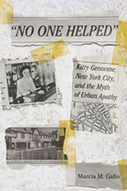“No One Helped”: Kitty Genovese, New York City, and the Myth of Urban Apathy

Author:Marcia M. Gallo
Publisher: Ithaca, NY: Cornell University Press, 2015. 240p.
Reviewer: Jennifer K. Wood | May 2016
Early in the morning on March 13, 1964, Catherine “Kitty” Genovese lay in the foyer of an apartment building a few doors down from her own in the Kew Gardens section of Queens, New York. She was bleeding from multiple and ultimately fatal stab wounds inflicted by Winston Moseley. Moseley eventually confessed not only to Genovese’s murder and sexual assault, but also to the murders and sexual assaults of Anna Mae Johnson and Barbara Kralik, as well as at least three other assaults on women, and several burglaries in the area. As Marcia M. Gallo recounts in “No One Helped”: Kitty Genovese, New York City, and the Myth of Urban Apathy, though Genovese’s murder was prominently reported in local papers, the New York Times initially gave it scant coverage with “four short paragraphs on page twenty-six on March 14” (xix). That changed on March 27, 1964, when Times reporter Martin Gansberg’s story appeared on the front page, the headline declaring: “37 Who Saw Murder Didn’t Call the Police.” From then on, Genovese’s name and her murder became signifiers of the disintegration of neighborly relations in an impersonal city, the disease of “urban apathy,” “bystander syndrome,” and the dangers posed to young women who seek out city life. Gallo’s detailed, carefully researched, and readable book explores the media, social, cultural, political, and geographical landscape of responses to Genovese’s murder in order to argue that “urban apathy” was a myth; and to offer a more complete portrait of Kitty Genovese’s short life, and provide an alternate record of New Yorkers’ growing engagement in political and social change in the mid-1960s.
As Gallo documents, contrary to the headline that accompanied Gansberg’s story, some of Genovese’s neighbors did respond to her cries for help: one man called out from his window and briefly scared Moseley away; at least two people called the police; and Genovese’s neighbor, Sophie Farrar, rushed to her aid after being alerted by another neighbor’s phone call. Farrar held Genovese in her arms as the police and ambulance arrived. Moreover, Moseley was apprehended five days after the murder because of quick action by neighbors who spotted him burglarizing a home. While the “37 witnesses” never materialized, a couple did tell investigators that they heard screams but thought it was a “lovers’ quarrel” and so did not respond. Another neighbor—and friend of Genovese’s—who lived in the building where she sought refuge may have opened his door and shut it when he heard her cry out. Regardless of these varied responses to her cries for help, the association of Kitty Genovese’s murder with a brutal city comprised of indifferent neighbors persists even today. As Gallo asserts, “the story of Kitty Genovese had become a worldwide sensation because of the Times’ explicit and repeated assertions that more than three dozen people had watched her die and did nothing” (160).
Gallo’s examination of the New York Times coverage of the case illuminates the powerful role of A.M. Rosenthal, a Pulitzer Prize-winning foreign reporter, who became metropolitan desk editor in 1963. (Rosenthal eventually became managing editor and then executive editor of the Times, and was an ardent champion of the “War on Drugs.”) Determined to make the Times more relevant to New Yorkers, he ramped up local news reporting with crime news as a staple. In addition, responding to the reactions of Times readers to Gansberg’s story, Rosenthal published an essay entitled “Study of Sickness Called Apathy,” in the Times Sunday Magazine. As Gallo argues, Rosenthal’s commentary “focused on individual responses to wrongdoing and discounted or disparaged the power of government, organizations, and the media in working toward, or thwarting, social change” (71). Rosenthal followed his essay with a book that extended those arguments, published three months after the murder: Thirty-Eight Witnesses: The Kitty Genovese Case. (The “38 witnesses,” according to Rosenthal, referred to the one person who did pick up the phone and report the crime.) Gallo provides ample evidence of the community organizing already underway in the city as the social action that characterized the 1960s moved into full swing. In doing so, she brings into sharp relief the narrow framework of individual responsibility of the Times’s coverage of Genovese’s murder in general and Rosenthal’s moralizing commentary in particular.
Gallo’s analysis of media coverage of the crime also offers an important examination of the persistent image of the “ideal victim” as a young, straight, white woman. Though the Times coverage did not mention Genovese’s or Moseley’s race (she was white and he was black), photos accompanying the stories elsewhere made race apparent. No pictures of Anna Mae Johnson, the young black woman murdered by Moseley in February, 1964, appeared in the reporting. Indeed, Moseley was never even convicted of Johnson’s murder. Moreover, as Gallo recounts, Genovese lived in Queens with her girlfriend Mary Zielonko, though Rosenthal’s writing characterized her as living alone. Gallo argues that Rosenthal knew “full well that Genovese shared her apartment and her life with Mary Ann Zielonko” and his characterization of her as living alone “can only be explained as an attempt to continue to fit Genovese into an Ideal Victim mold and keep the story’s focus on the neighbor’s apathy” (175).
In providing a fuller account of Genovese’s life, Gallo also offers a history of gay experiences—especially the experiences of lesbians—in New York City in the mid-1960s. “It was only at gay or lesbian bars in Greenwich Village…that Genovese and Zielonko felt free to let their guard down” (28). While a small circle of their friends knew about Zielonko and Genovese’s relationship, as Gallo explains, “They could not jeopardize their jobs or their new home to reveal too much to the wrong people” (28). At that time, news and magazine articles were depicting homosexuality as pathological. In fact, in December 1963, a few months before Genovese’s murder and at Rosenthal’s suggestion, the Times published a front-page article headlined “Growth of Overt Homosexuality in City Provokes Wide Concern.” The focus on gay men in the story, drew complaints from the Daughters of Bilitis, “the only lesbian rights organization in the United States at that time” (30). Gallo’s exploration notes that lesbians remained largely invisible, even in disparaging and alarmist reporting about homosexuality.
In addition, Gallo treats readers to a study of the social, cultural, and political development of Queens, New York in the mid-1960s. Queens and the Kew Gardens neighborhood where Genovese lived and was murdered became central to the story the Times told—indeed, it was the story. As Gallo explains, the post-World War II population and housing boom, changes in immigration policy, and white flight from the city fueled the development of Queens neighborhoods as a “collection of villages” shaped by differing nationalities and cultures. In the mid-1960s, Queens seemed to promise its residents a semi-suburban life protected from the dangers of urban living—a sense that made Genovese’s murder even more shocking. As Gallo argues, “[t]he unspoken assumption” in Gansberg’s story “is that people who lived in this neighborhood belonged to a tight-knit community, a village where people knew and looked out for each other. A large part of the shock value of the Kitty Genovese story was the sudden realization that this assumption may not be true” (15-16).
In the decades following Genovese’s assault and murder, the myth of urban apathy fueled a number of policy changes, which Gallo explores in detail to great effect. The story hastened development of the 911 emergency call system, for example, which was not in place in 1964. “Good Samaritan” laws were passed protecting those who intervene from liability. Feminist advocates working in the movement to raise awareness about and end violence against women also referenced Kitty Genovese’s murder and sexual assault in their challenges of police responses to, media coverage of, and assumptions about women’s victimization—especially the characterizing of domestic violence as “lovers’ quarrels” that minimized the dangers women faced.
Just as important, Gallo traces the evolving political landscape in New York City to explore how the myth of urban apathy shaped policies into the 1980s and 1990s. Concerns about rampant crime in the city in the 1980s fueled heavy-handed crime-control responses supported by the “broken-windows” theory of policing espoused by James Q. Wilson and George Kelling. They argued for tough enforcement of “quality of life” crimes such as panhandling, and public intoxication and urination and panhandling. In the 1990s, Mayor Rudolph Guiliani implemented “zero tolerance” practices that included “stop and frisk” policing. As Gallo details, while these measures may have made middle-class white New Yorkers feel safer, “’zero tolerance’ under the Guiliani administration meant increased brutality, harassment, and racial and sexual profiling in many New York communities” (145).
Gallo’s thorough critique of the myth of urban apathy would be productive reading in a number of college classrooms, offering a case study for upper-level criminal justice, journalism, history, sociology, popular culture, gender studies, and communication students. Her careful research and mastery of the details, coupled with her critical approach and solid argument, provide a compelling case, and a useful model for scholars to explore the way a news story gets framed, is developed, and then takes on a life of its own.
In the more than fifty years since Genovese’s murder, a fuller story has emerged. Even the New York Times has corrected its reporting. Yet the myth of urban apathy persists. Like Gallo, and no doubt many women who came of age in the 1960s and 70s, I also have been haunted by the story told about neighbors who did not respond to Genovese’s cries for help. When walking my dog alone in the pre-dawn hours, I have often asked myself: who would help if I needed it? Would my neighbors come to my aid? After finishing Gallo’s convincing book, I am surprised that those questions still creep into my thoughts while walking alone in the dark. In spite of myself, and this fine work, the gripping myth of urban apathy retains its fearsome hold.
Jennifer K. Wood, Ph.D., Associate Professor of Communication Arts & Sciences, Penn State New Kensington


